Financial Accounting Report: Beachlife Ltd Case Study Analysis
VerifiedAdded on 2020/05/16
|7
|1655
|59
Report
AI Summary
This financial accounting report analyzes two key scenarios faced by Beachlife Ltd. The first involves a legal claim against the company for patent infringement, requiring an assessment of the probability of loss and the appropriate accounting treatment under AASB 137. The report determines the contingent liability to be disclosed in the financial statements based on the likelihood of the claim's outcome and the potential financial implications. The second scenario examines a sales agreement with Alpine Ltd, focusing on the recognition of revenue, the accounting for maintenance service obligations, and the treatment of a potential refund. The report applies accounting principles to determine the appropriate classification of these items in the financial statements, including sales revenue, current liabilities, and contingent liabilities. The report also emphasizes the differences between contingent liabilities and provisions, highlighting the importance of accurate financial reporting and disclosure.

Running head: FINANCIAL ACCOUNTING
Financial Accounting
Name of the Student
Name of the University
Author Note
Financial Accounting
Name of the Student
Name of the University
Author Note
Paraphrase This Document
Need a fresh take? Get an instant paraphrase of this document with our AI Paraphraser
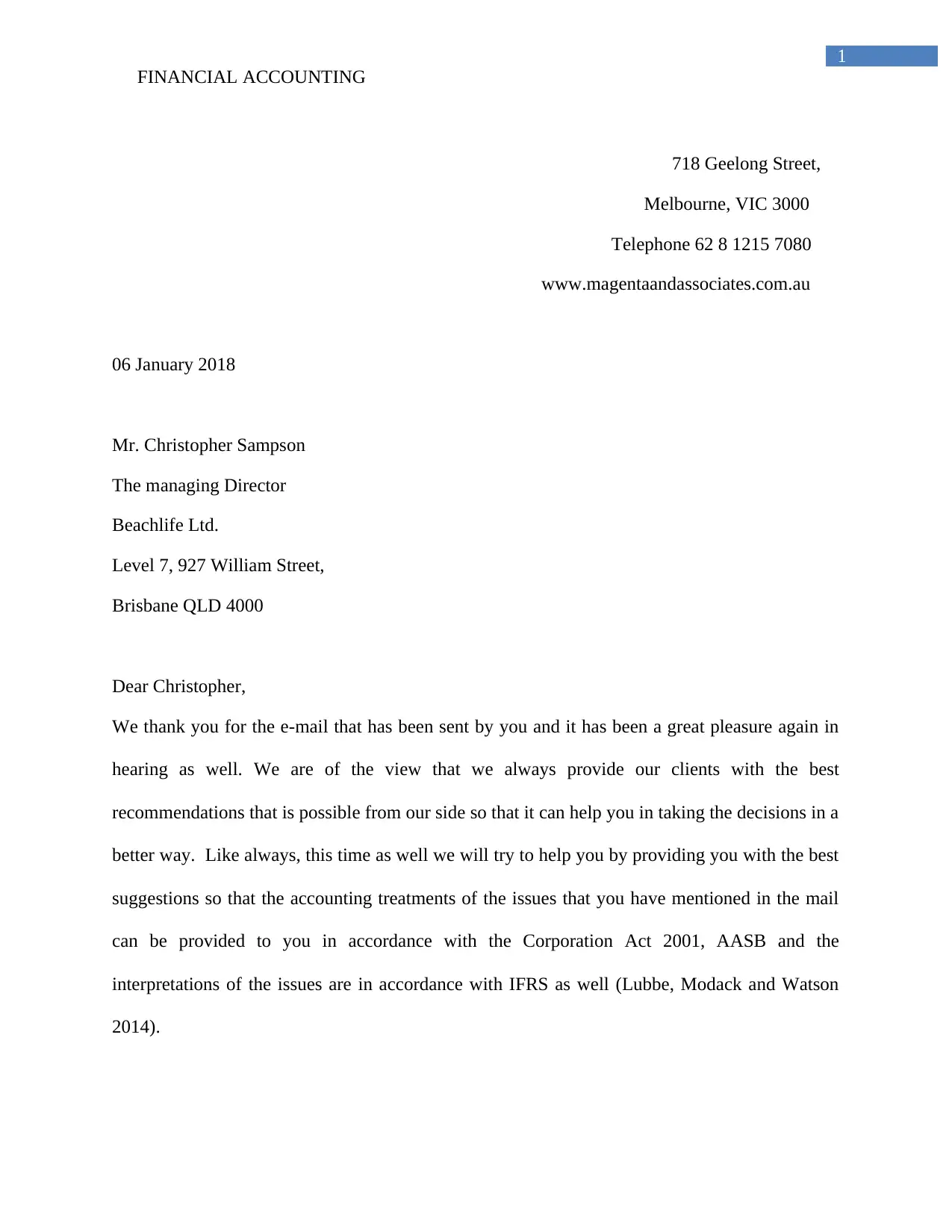
1
FINANCIAL ACCOUNTING
718 Geelong Street,
Melbourne, VIC 3000
Telephone 62 8 1215 7080
www.magentaandassociates.com.au
06 January 2018
Mr. Christopher Sampson
The managing Director
Beachlife Ltd.
Level 7, 927 William Street,
Brisbane QLD 4000
Dear Christopher,
We thank you for the e-mail that has been sent by you and it has been a great pleasure again in
hearing as well. We are of the view that we always provide our clients with the best
recommendations that is possible from our side so that it can help you in taking the decisions in a
better way. Like always, this time as well we will try to help you by providing you with the best
suggestions so that the accounting treatments of the issues that you have mentioned in the mail
can be provided to you in accordance with the Corporation Act 2001, AASB and the
interpretations of the issues are in accordance with IFRS as well (Lubbe, Modack and Watson
2014).
FINANCIAL ACCOUNTING
718 Geelong Street,
Melbourne, VIC 3000
Telephone 62 8 1215 7080
www.magentaandassociates.com.au
06 January 2018
Mr. Christopher Sampson
The managing Director
Beachlife Ltd.
Level 7, 927 William Street,
Brisbane QLD 4000
Dear Christopher,
We thank you for the e-mail that has been sent by you and it has been a great pleasure again in
hearing as well. We are of the view that we always provide our clients with the best
recommendations that is possible from our side so that it can help you in taking the decisions in a
better way. Like always, this time as well we will try to help you by providing you with the best
suggestions so that the accounting treatments of the issues that you have mentioned in the mail
can be provided to you in accordance with the Corporation Act 2001, AASB and the
interpretations of the issues are in accordance with IFRS as well (Lubbe, Modack and Watson
2014).
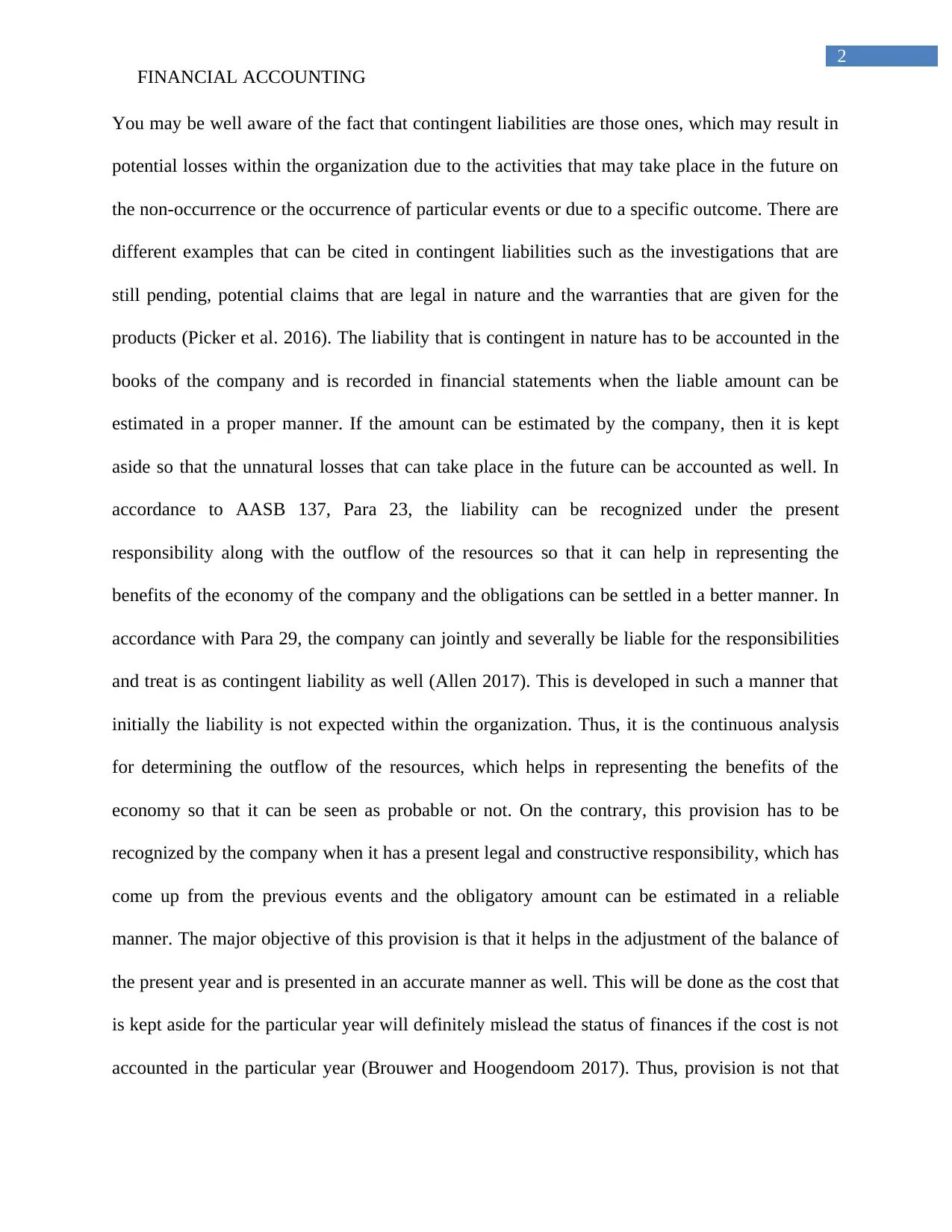
2
FINANCIAL ACCOUNTING
You may be well aware of the fact that contingent liabilities are those ones, which may result in
potential losses within the organization due to the activities that may take place in the future on
the non-occurrence or the occurrence of particular events or due to a specific outcome. There are
different examples that can be cited in contingent liabilities such as the investigations that are
still pending, potential claims that are legal in nature and the warranties that are given for the
products (Picker et al. 2016). The liability that is contingent in nature has to be accounted in the
books of the company and is recorded in financial statements when the liable amount can be
estimated in a proper manner. If the amount can be estimated by the company, then it is kept
aside so that the unnatural losses that can take place in the future can be accounted as well. In
accordance to AASB 137, Para 23, the liability can be recognized under the present
responsibility along with the outflow of the resources so that it can help in representing the
benefits of the economy of the company and the obligations can be settled in a better manner. In
accordance with Para 29, the company can jointly and severally be liable for the responsibilities
and treat is as contingent liability as well (Allen 2017). This is developed in such a manner that
initially the liability is not expected within the organization. Thus, it is the continuous analysis
for determining the outflow of the resources, which helps in representing the benefits of the
economy so that it can be seen as probable or not. On the contrary, this provision has to be
recognized by the company when it has a present legal and constructive responsibility, which has
come up from the previous events and the obligatory amount can be estimated in a reliable
manner. The major objective of this provision is that it helps in the adjustment of the balance of
the present year and is presented in an accurate manner as well. This will be done as the cost that
is kept aside for the particular year will definitely mislead the status of finances if the cost is not
accounted in the particular year (Brouwer and Hoogendoom 2017). Thus, provision is not that
FINANCIAL ACCOUNTING
You may be well aware of the fact that contingent liabilities are those ones, which may result in
potential losses within the organization due to the activities that may take place in the future on
the non-occurrence or the occurrence of particular events or due to a specific outcome. There are
different examples that can be cited in contingent liabilities such as the investigations that are
still pending, potential claims that are legal in nature and the warranties that are given for the
products (Picker et al. 2016). The liability that is contingent in nature has to be accounted in the
books of the company and is recorded in financial statements when the liable amount can be
estimated in a proper manner. If the amount can be estimated by the company, then it is kept
aside so that the unnatural losses that can take place in the future can be accounted as well. In
accordance to AASB 137, Para 23, the liability can be recognized under the present
responsibility along with the outflow of the resources so that it can help in representing the
benefits of the economy of the company and the obligations can be settled in a better manner. In
accordance with Para 29, the company can jointly and severally be liable for the responsibilities
and treat is as contingent liability as well (Allen 2017). This is developed in such a manner that
initially the liability is not expected within the organization. Thus, it is the continuous analysis
for determining the outflow of the resources, which helps in representing the benefits of the
economy so that it can be seen as probable or not. On the contrary, this provision has to be
recognized by the company when it has a present legal and constructive responsibility, which has
come up from the previous events and the obligatory amount can be estimated in a reliable
manner. The major objective of this provision is that it helps in the adjustment of the balance of
the present year and is presented in an accurate manner as well. This will be done as the cost that
is kept aside for the particular year will definitely mislead the status of finances if the cost is not
accounted in the particular year (Brouwer and Hoogendoom 2017). Thus, provision is not that
⊘ This is a preview!⊘
Do you want full access?
Subscribe today to unlock all pages.

Trusted by 1+ million students worldwide
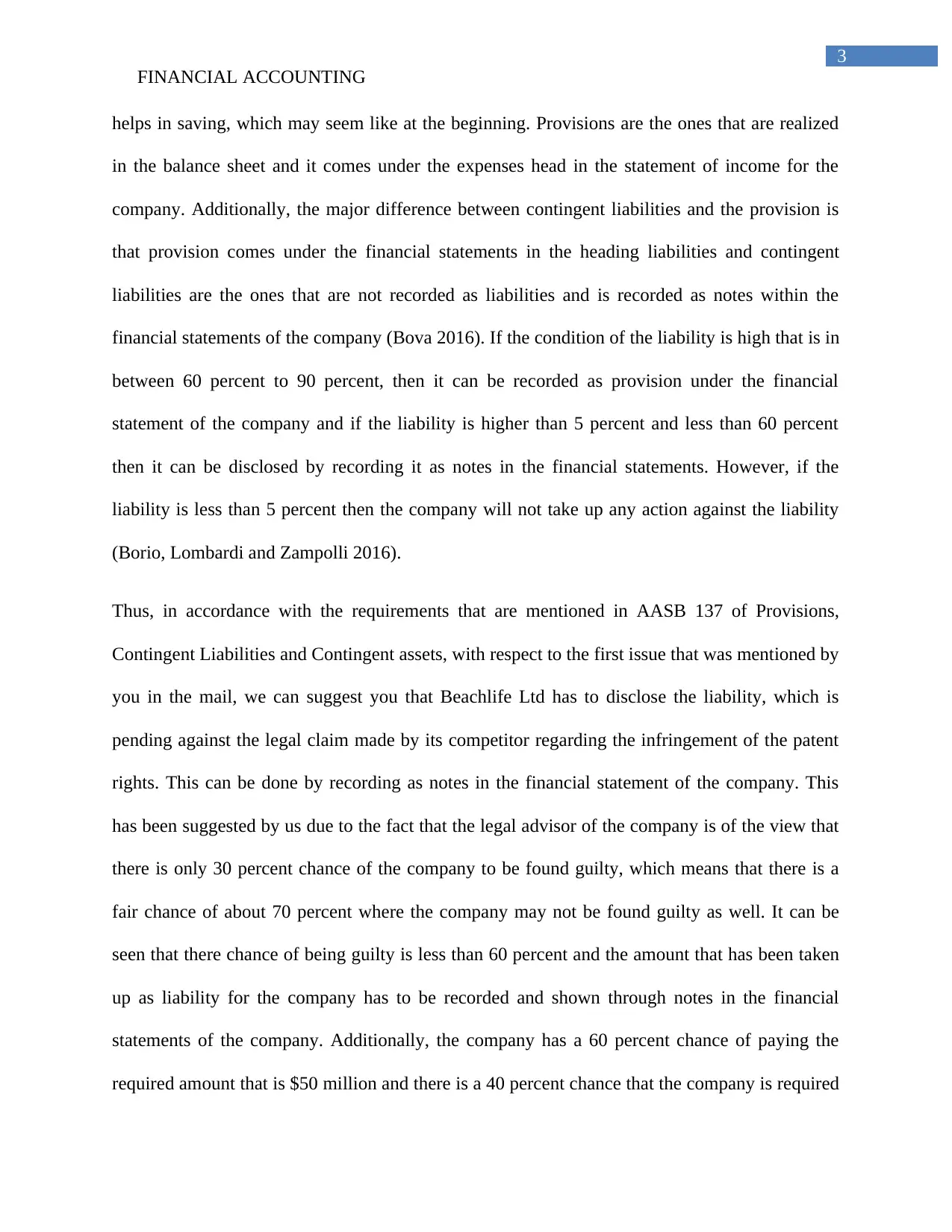
3
FINANCIAL ACCOUNTING
helps in saving, which may seem like at the beginning. Provisions are the ones that are realized
in the balance sheet and it comes under the expenses head in the statement of income for the
company. Additionally, the major difference between contingent liabilities and the provision is
that provision comes under the financial statements in the heading liabilities and contingent
liabilities are the ones that are not recorded as liabilities and is recorded as notes within the
financial statements of the company (Bova 2016). If the condition of the liability is high that is in
between 60 percent to 90 percent, then it can be recorded as provision under the financial
statement of the company and if the liability is higher than 5 percent and less than 60 percent
then it can be disclosed by recording it as notes in the financial statements. However, if the
liability is less than 5 percent then the company will not take up any action against the liability
(Borio, Lombardi and Zampolli 2016).
Thus, in accordance with the requirements that are mentioned in AASB 137 of Provisions,
Contingent Liabilities and Contingent assets, with respect to the first issue that was mentioned by
you in the mail, we can suggest you that Beachlife Ltd has to disclose the liability, which is
pending against the legal claim made by its competitor regarding the infringement of the patent
rights. This can be done by recording as notes in the financial statement of the company. This
has been suggested by us due to the fact that the legal advisor of the company is of the view that
there is only 30 percent chance of the company to be found guilty, which means that there is a
fair chance of about 70 percent where the company may not be found guilty as well. It can be
seen that there chance of being guilty is less than 60 percent and the amount that has been taken
up as liability for the company has to be recorded and shown through notes in the financial
statements of the company. Additionally, the company has a 60 percent chance of paying the
required amount that is $50 million and there is a 40 percent chance that the company is required
FINANCIAL ACCOUNTING
helps in saving, which may seem like at the beginning. Provisions are the ones that are realized
in the balance sheet and it comes under the expenses head in the statement of income for the
company. Additionally, the major difference between contingent liabilities and the provision is
that provision comes under the financial statements in the heading liabilities and contingent
liabilities are the ones that are not recorded as liabilities and is recorded as notes within the
financial statements of the company (Bova 2016). If the condition of the liability is high that is in
between 60 percent to 90 percent, then it can be recorded as provision under the financial
statement of the company and if the liability is higher than 5 percent and less than 60 percent
then it can be disclosed by recording it as notes in the financial statements. However, if the
liability is less than 5 percent then the company will not take up any action against the liability
(Borio, Lombardi and Zampolli 2016).
Thus, in accordance with the requirements that are mentioned in AASB 137 of Provisions,
Contingent Liabilities and Contingent assets, with respect to the first issue that was mentioned by
you in the mail, we can suggest you that Beachlife Ltd has to disclose the liability, which is
pending against the legal claim made by its competitor regarding the infringement of the patent
rights. This can be done by recording as notes in the financial statement of the company. This
has been suggested by us due to the fact that the legal advisor of the company is of the view that
there is only 30 percent chance of the company to be found guilty, which means that there is a
fair chance of about 70 percent where the company may not be found guilty as well. It can be
seen that there chance of being guilty is less than 60 percent and the amount that has been taken
up as liability for the company has to be recorded and shown through notes in the financial
statements of the company. Additionally, the company has a 60 percent chance of paying the
required amount that is $50 million and there is a 40 percent chance that the company is required
Paraphrase This Document
Need a fresh take? Get an instant paraphrase of this document with our AI Paraphraser
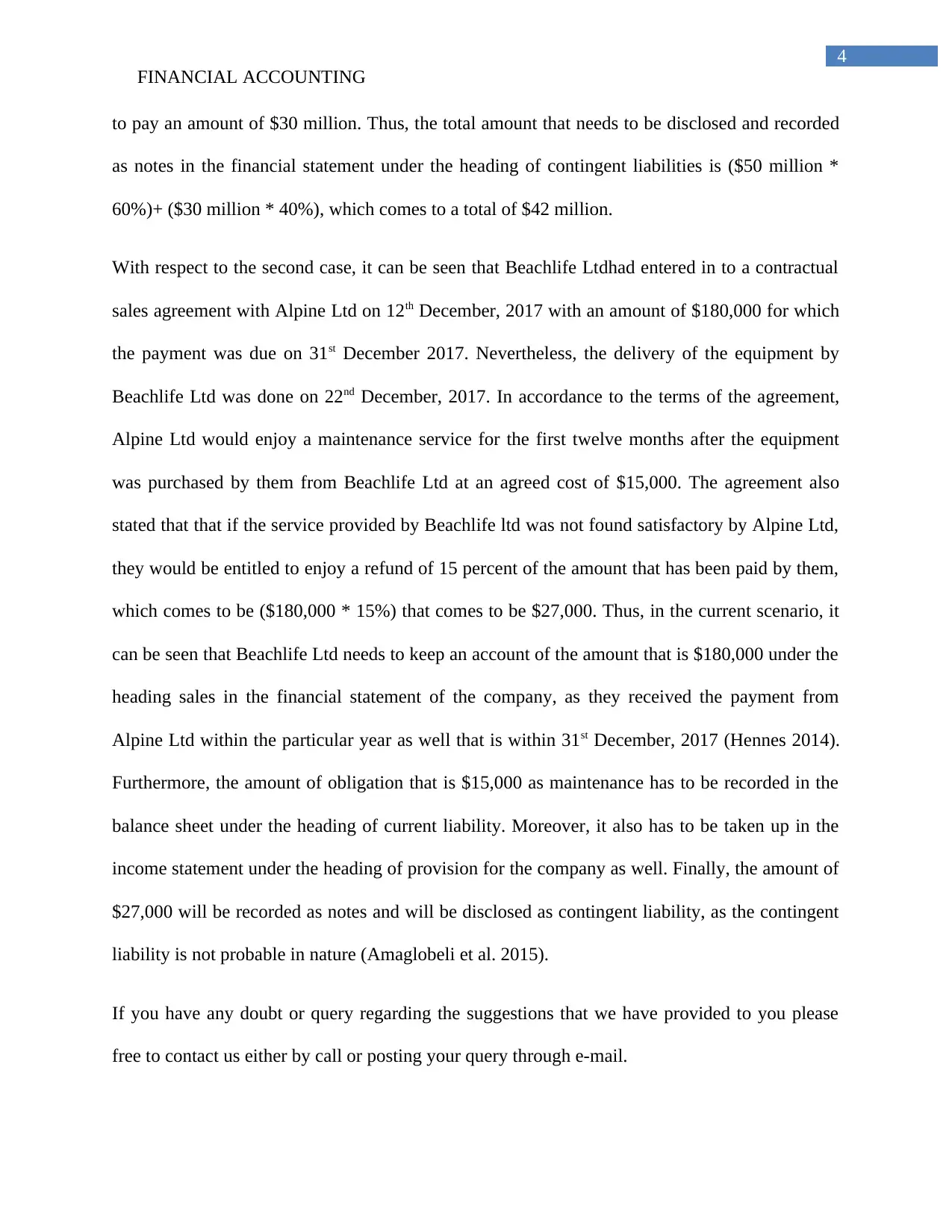
4
FINANCIAL ACCOUNTING
to pay an amount of $30 million. Thus, the total amount that needs to be disclosed and recorded
as notes in the financial statement under the heading of contingent liabilities is ($50 million *
60%)+ ($30 million * 40%), which comes to a total of $42 million.
With respect to the second case, it can be seen that Beachlife Ltdhad entered in to a contractual
sales agreement with Alpine Ltd on 12th December, 2017 with an amount of $180,000 for which
the payment was due on 31st December 2017. Nevertheless, the delivery of the equipment by
Beachlife Ltd was done on 22nd December, 2017. In accordance to the terms of the agreement,
Alpine Ltd would enjoy a maintenance service for the first twelve months after the equipment
was purchased by them from Beachlife Ltd at an agreed cost of $15,000. The agreement also
stated that that if the service provided by Beachlife ltd was not found satisfactory by Alpine Ltd,
they would be entitled to enjoy a refund of 15 percent of the amount that has been paid by them,
which comes to be ($180,000 * 15%) that comes to be $27,000. Thus, in the current scenario, it
can be seen that Beachlife Ltd needs to keep an account of the amount that is $180,000 under the
heading sales in the financial statement of the company, as they received the payment from
Alpine Ltd within the particular year as well that is within 31st December, 2017 (Hennes 2014).
Furthermore, the amount of obligation that is $15,000 as maintenance has to be recorded in the
balance sheet under the heading of current liability. Moreover, it also has to be taken up in the
income statement under the heading of provision for the company as well. Finally, the amount of
$27,000 will be recorded as notes and will be disclosed as contingent liability, as the contingent
liability is not probable in nature (Amaglobeli et al. 2015).
If you have any doubt or query regarding the suggestions that we have provided to you please
free to contact us either by call or posting your query through e-mail.
FINANCIAL ACCOUNTING
to pay an amount of $30 million. Thus, the total amount that needs to be disclosed and recorded
as notes in the financial statement under the heading of contingent liabilities is ($50 million *
60%)+ ($30 million * 40%), which comes to a total of $42 million.
With respect to the second case, it can be seen that Beachlife Ltdhad entered in to a contractual
sales agreement with Alpine Ltd on 12th December, 2017 with an amount of $180,000 for which
the payment was due on 31st December 2017. Nevertheless, the delivery of the equipment by
Beachlife Ltd was done on 22nd December, 2017. In accordance to the terms of the agreement,
Alpine Ltd would enjoy a maintenance service for the first twelve months after the equipment
was purchased by them from Beachlife Ltd at an agreed cost of $15,000. The agreement also
stated that that if the service provided by Beachlife ltd was not found satisfactory by Alpine Ltd,
they would be entitled to enjoy a refund of 15 percent of the amount that has been paid by them,
which comes to be ($180,000 * 15%) that comes to be $27,000. Thus, in the current scenario, it
can be seen that Beachlife Ltd needs to keep an account of the amount that is $180,000 under the
heading sales in the financial statement of the company, as they received the payment from
Alpine Ltd within the particular year as well that is within 31st December, 2017 (Hennes 2014).
Furthermore, the amount of obligation that is $15,000 as maintenance has to be recorded in the
balance sheet under the heading of current liability. Moreover, it also has to be taken up in the
income statement under the heading of provision for the company as well. Finally, the amount of
$27,000 will be recorded as notes and will be disclosed as contingent liability, as the contingent
liability is not probable in nature (Amaglobeli et al. 2015).
If you have any doubt or query regarding the suggestions that we have provided to you please
free to contact us either by call or posting your query through e-mail.
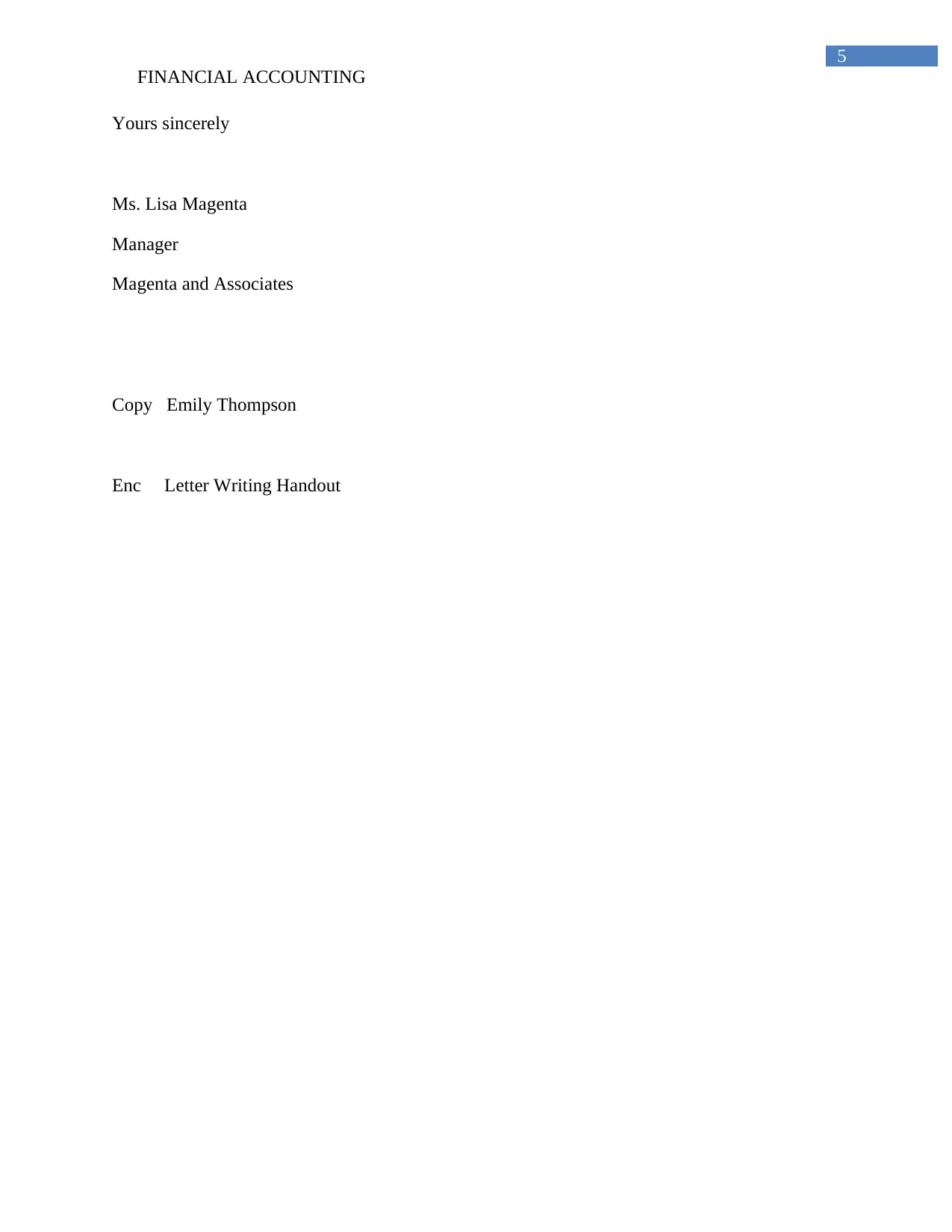
5
FINANCIAL ACCOUNTING
Yours sincerely
Ms. Lisa Magenta
Manager
Magenta and Associates
Copy Emily Thompson
Enc Letter Writing Handout
FINANCIAL ACCOUNTING
Yours sincerely
Ms. Lisa Magenta
Manager
Magenta and Associates
Copy Emily Thompson
Enc Letter Writing Handout
⊘ This is a preview!⊘
Do you want full access?
Subscribe today to unlock all pages.

Trusted by 1+ million students worldwide
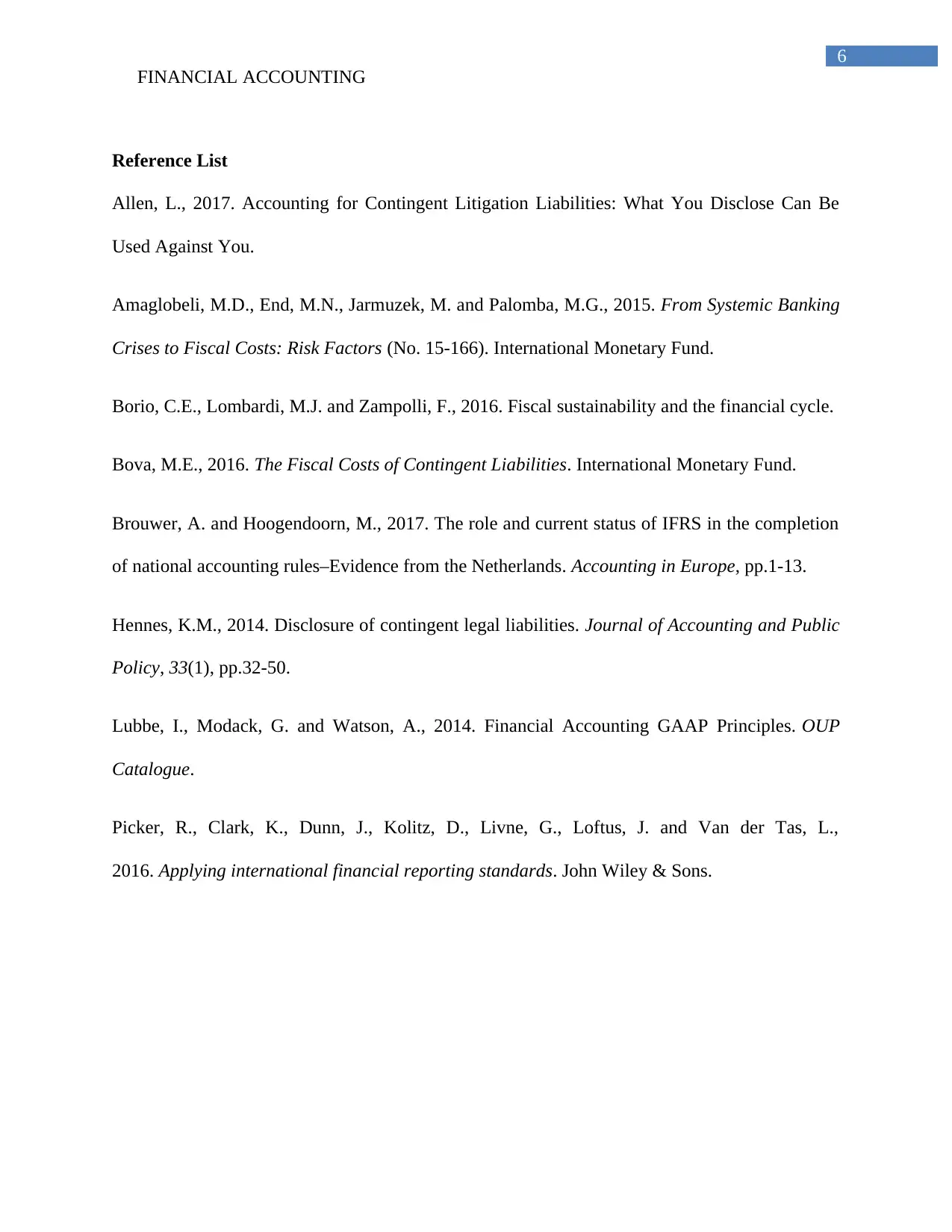
6
FINANCIAL ACCOUNTING
Reference List
Allen, L., 2017. Accounting for Contingent Litigation Liabilities: What You Disclose Can Be
Used Against You.
Amaglobeli, M.D., End, M.N., Jarmuzek, M. and Palomba, M.G., 2015. From Systemic Banking
Crises to Fiscal Costs: Risk Factors (No. 15-166). International Monetary Fund.
Borio, C.E., Lombardi, M.J. and Zampolli, F., 2016. Fiscal sustainability and the financial cycle.
Bova, M.E., 2016. The Fiscal Costs of Contingent Liabilities. International Monetary Fund.
Brouwer, A. and Hoogendoorn, M., 2017. The role and current status of IFRS in the completion
of national accounting rules–Evidence from the Netherlands. Accounting in Europe, pp.1-13.
Hennes, K.M., 2014. Disclosure of contingent legal liabilities. Journal of Accounting and Public
Policy, 33(1), pp.32-50.
Lubbe, I., Modack, G. and Watson, A., 2014. Financial Accounting GAAP Principles. OUP
Catalogue.
Picker, R., Clark, K., Dunn, J., Kolitz, D., Livne, G., Loftus, J. and Van der Tas, L.,
2016. Applying international financial reporting standards. John Wiley & Sons.
FINANCIAL ACCOUNTING
Reference List
Allen, L., 2017. Accounting for Contingent Litigation Liabilities: What You Disclose Can Be
Used Against You.
Amaglobeli, M.D., End, M.N., Jarmuzek, M. and Palomba, M.G., 2015. From Systemic Banking
Crises to Fiscal Costs: Risk Factors (No. 15-166). International Monetary Fund.
Borio, C.E., Lombardi, M.J. and Zampolli, F., 2016. Fiscal sustainability and the financial cycle.
Bova, M.E., 2016. The Fiscal Costs of Contingent Liabilities. International Monetary Fund.
Brouwer, A. and Hoogendoorn, M., 2017. The role and current status of IFRS in the completion
of national accounting rules–Evidence from the Netherlands. Accounting in Europe, pp.1-13.
Hennes, K.M., 2014. Disclosure of contingent legal liabilities. Journal of Accounting and Public
Policy, 33(1), pp.32-50.
Lubbe, I., Modack, G. and Watson, A., 2014. Financial Accounting GAAP Principles. OUP
Catalogue.
Picker, R., Clark, K., Dunn, J., Kolitz, D., Livne, G., Loftus, J. and Van der Tas, L.,
2016. Applying international financial reporting standards. John Wiley & Sons.
1 out of 7
Related Documents
Your All-in-One AI-Powered Toolkit for Academic Success.
+13062052269
info@desklib.com
Available 24*7 on WhatsApp / Email
![[object Object]](/_next/static/media/star-bottom.7253800d.svg)
Unlock your academic potential
Copyright © 2020–2025 A2Z Services. All Rights Reserved. Developed and managed by ZUCOL.





